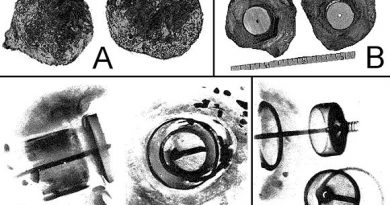5 Weirdest Unexplained Mysteries of World
Some things, science just can’t explain. How could an explosion 1000 times the size of the bomb dropped on Hiroshima not take any human lives? How did the fumes emitted by a living human cause more than twenty people to become ill? And why is there a bridge in Scotland that compels dogs to throw themselves off it? We look into some of the strangest mysteries ever to be documented on this earth.
The Tunguska Event
In the early morning of June 30, 1908, a huge explosion 1,000 times more powerful than the atomic bomb dropped on Hiroshima flattened 2000 square kilometers of forest in the sparsely populated Siberian Taiga. Astoundingly, there were no known human casualties from the event.
Evenki natives and Russian settlers played witness to an intense blue light, almost as bright as the sun, moving across the sky. It was almost ten minutes later that there was a flash and a huge sound, accompanied by a shock wave that broke windows and knocked people off their feet even hundreds of kilometres away.
The explosion was registered across Eurasia, but even more astoundingly, the event caused the skies to glow over the next few nights — a phenomenon visible from across Europe and Asia. Interestingly, a very similar glowing-sky event was reproduced later in the century by space shuttle launches. The following comes from an eyewitness account of the event
At breakfast time I was sitting by the house at Vanavara Trading Post, facing north. … I suddenly saw that directly to the north … the sky split in two and fire appeared high and wide over the forest. The split in the sky grew larger, and the entire northern side was covered with fire. At that moment I became so hot that I couldn’t bear it, as if my shirt was on fire; from the northern side, where the fire was, came strong heat. I wanted to tear off my shirt and throw it down, but then the sky shut closed, and a strong thump sounded, and I was thrown a few metres. I lost my senses for a moment, but then my wife ran out and led me to the house. After that such noise came, as if rocks were falling or cannons were firing.
While the Tunguska event is technically classified as an impact event, no trace of meteoric impact has ever been found. No object was ever detected approaching the Earth, either. Other theories propose that the object could have been a comet — composed of ice rather than rock — that disintegrated as it entered the atmosphere.
The most scientifically accepted explanation is that of an air burst from an asteroid or comet, or even an explosion caused by the ignition of natural gas from within the earth’s crust. However no one has ever been able to confirm the cause of the huge explosion. With an event like this, conspiracies are bound to crop up.
Alternate explanations range from alien visitors to supernatural events — some have even hypothesised that a miniature black hole impacted the earth. Considering the similarities between Tunguska and much later space shuttle launches, the UFO theory is the most popular alternate explanation.
Also unusual is the extreme remoteness of the occurrence. The Tunguska area is essentially uninhabitable for humans, and the huge explosion caused no known casualties – though charred reindeer corpses were found in their hundreds. If this had occurred over a highly populated metropolitan area, it could have razed an entire city and wiped out literally millions of people.
Was the location of the explosion just divine good luck, or is it evidence that the event was planned by intelligent beings, whether human or otherwise?
The Toxic Lady
One night in February 1994, a woman was admitted to the emergency room of Riverside General Hospital suffering the effects of advanced cervical cancer. Something else was wrong, however. The woman had an oily sheen covering her skin, and she had a fruity, garlic-like odor about her. When her blood was drawn, the tube had a vaguely ammonia-like smell.
At this point, attending nurses and medical professionals began to pass out. The first was Susan Kane, the nurse who had drawn blood from the woman. Once she was removed from the room, the medical resident Julie Gorchynski began to feel lightheaded, and she also passed out after leaving the trauma room. A respiratory therapist named Maureen Welch was the third to pass out, at which point the emergency room was evacuated aside from a skeleton crew who remained to look after the toxic woman.
The woman, a housewife named Gloria Ramirez, died after 45 minutes of treatment, but her unusually potent toxicity will live on as one of medicine’s most enduring mysteries. Overall 23 people became ill and 5 were hospitalised, with those who had worked within two feet of Ramirez being at the highest risk. Symptoms included loss of consciousness, shortness of breath and muscle spasms, though all affected appeared to have normal blood tests after the exposure. An initial investigation blamed the phenomena on mass hysteria.
Some of the medical professionals who had been exposed to Ramirez’s odd sickening effect denied the idea that they could have been affected by mass hysteria, however, denying this conclusion. Maureen Welch recalled waking after she had passed out, finding herself unable to move her limbs. Gorchynski experienced particularly severe symptoms in the aftermath of her exposure — after she had passed out on the night Ramirez was admitted Gorchynski suffered from apnea, where her breathing would intermittently stop, and then start again. She spent two weeks after the incident in the intensive care unit with breathing problems, and later developed hepatitis and avascular necrosis in her knees.
Livermore Labs was called in to investigate after the initial conclusion was deemed unsatisfactory, and this team hypothesised that Ramirez could have been using a compound called dimethyl sulfoxide or DMSO as a home remedy for pain. It is known for this use, and users even report it having a garlicky odour. The compound is a solvent and a powerful degreaser, sold at hardware stores.
Livermore scientists theorised that kidney failure in Ramirez’s body could have led to a buildup of DMSO in her blood. Then, when paramedics administered oxygen, it could have combined to form DMSO2, or dimethyl sulfone. This could be an explanation for the crystals found in Ramirez’s blood, as DMSO2 can crystallise at room temperature. From there, the electric shocks could have converted the compound into dimethyl sulfate or DMSO4, a powerful poisonous gas.
But some people aren’t convinced. No one has ever been able to reproduce the chemical reaction that supposedly occurred within Ramirez’s body, and others have pointed out that the symptoms of those in the trauma room do not align with the symptoms of exposure to dimethyl sulfate, which reacts more like tear gas. To make the case even more questionable, the body was not released for an independent autopsy until it was badly decomposed and largely contaminated. Her heart was also missing when it was handed over. Could they have been trying to cover something up? Some believe so.
An article in the now defunct New Times Los Angeles called the DMSO conclusion ridiculous, and put forth their own theory – that Riverside General was harbouring a hidden drug lab.
It’s sensational, yes, but not entirely unlikely. Hospital staff could easily order the chemicals needed without suspicion, and the building is already equipped with legitimate labs. Beyond this, Riverside was even known as the “methamphetamine capital of the world” in the years surrounding this case. A similar operation was uncovered in a hospital in Denver in 1990.
If this was the case, then Riverside likely would have been producing chemical ‘precursors’ that could then be turned into meth, rather than the finished product itself. Some of these chemicals are known to release dangerous chemical fumes like those encountered in the trauma room on the night of Ramirez’s death.
Charles Cox, a Cal/OSHA district manager postulates that hospital staff could have been storing these chemicals in IV bags to be sent out on the black market, at which point one had accidentally been hooked up to Gloria Ramirez. Most of the staff who were strongly affected by the fumes were those who directly handled the woman’s IV lines.
It’s a plausible theory, and even more likely when you consider the secrecy that followed. Ramirez’s body was kept hidden away, the syringe used to draw her blood was lost, the bedding materials thrown away and the IV bag never tested. Her heart was never returned with the body.
Coverup, medical anomaly or something else entirely, someone has gone to lengths to make sure the truth about Riverside’s Toxic Lady is never discovered.
Dyatlov Pass
Everything weird seems to happen in Russia. In the early days of February 1959, a group of nine hikers failed to return from a challenging trek they had undertaken through the northern Ural mountains.
It wasn’t until they were more than a week overdue that the first search and rescue groups were sent — at first consisting of fellow teachers and students at the Ural Polytechnical Institute and later of military including search planes and helicopters. It took searchers almost a week to find the battered and slashed remains of the group’s tent — which was empty.
The tent was only the beginning of the Dyatlov Pass mystery, but it baffled the searchers. All the groups belongings and shoes had been left behind, and the tent was cut open from the inside as if they had fled in panic. Many different sets of footprints left by people wearing socks, a single shoe or even barefoot, led down towards the edge of the forest. Down here, the searchers found the remains of a fire — and the first two bodies.
These two hikers were dressed only in their underwear, and were shoeless. Branches on the tree they were under were broken at heights that suggested that the men were trying to climb up, or had climbed up before their death. In the stretch between this tree and the tent the searchers found three more bodies buried in the snow, their poses looking like they were attempting to return to the tent.
It was more than four months before the remaining four hikers were found in a ravine under four meters of snow, almost 100 meters further into the woods from the forest’s edge. These four were better dressed, as though the others had relinquished their clothing to them.
While some of these events are consistent with hypothermia and a phenomenon called ‘paradoxical undressing’ — where hypothermia sufferers will undress as they begin to feel unexpectedly hot as their nerves and mental faculties fail — there were still elements that didn’t make sense. Three of the hikers had fatal internal injuries, with one doctor comparing the force required for such trauma to be comparable to that of a car crash. Some sources even claimed that there were high doses of radioactive contamination on some of the bodies, while one witness claimed that the corpses had a “deep brown tan”.
While theories on what happened to the hikers range from cryptozoological to extra-terrestrial to the standard secret Russian weapons testing, it’s unlikely we’ll ever know what really happened on Dyatlov Pass.
Isdal Woman
If you’ve devoured all the details of the mysterious demise of the Somerton man — the so-called Tamam Shud case — then you’ll want to know about the eerily similar case of the Isdal Woman. With a burned body, a glamorous woman, multiple identities and mysterious men in black, the case strongly suggests that the Isdal Woman was involved in something beyond most people’s understanding.
On November 29, 1970, a man and his two young daughters came across the charred remains of a naked woman, hidden among rocks on a remote hiking trail of Norway’s Isdalen Valley. What remained of the woman’s neck was bruised from some sort of blunt force trauma. Near the body were a handful of pink sleeping pills, a packed lunch, an empty bottle of liqueur and two plastic bottles that had held gasoline.
Police called to the scene later found a burned out passport in the area. The autopsy showed that she had died from a combination of burns and carbon monoxide poisoning, while traces of at least 50 sleeping pills remained in her body. Her fingerprints were also found to have been sanded away.
22 years after the Somerton Man was found dead in South Australia, this case in Norway seemed to repeat those strange happenings all over again. In an odd reflection of the earlier event, two suitcases belonging to the woman were found checked in to a train station in Bergen. When searching through the possessions inside, police found that the labels had also been removed from every piece of clothing she owned. Also inside was a prescription for a lotion, on which the doctor’s name and date had been removed.
In the trunk was a small notebook in which the woman had jotted down several coded entries, though there was no key to the code. When police eventually cracked her code, it was found to detail dates and places of the woman’s previous travels.
Investigators were able to find out much more about the Isdal Woman than has ever been evident about the Somerton Man. She had dental work that was distinctive to Latin America. She spoke French, German, English and Dutch. She was fond of porridge and milk. She often changed rooms after checking in at various hotels. She had a provocative style of dress. She wore a number of different wigs, and one was found in her possessions along with several pairs of non-prescription glasses. She called herself an antiques collector from South Africa. She went by nine different identities when travelling around Europe: Jenevive Lancia, Claudia Tjelt, Vera Schlosseneck, Claudia Nielsen, Alexia Zarna-Merchez, Vera Jarle, Finella Lorck and Elizabeth Leen Hoywfer. None of them were her own.
The various sketches of her that exist are evocative — conjuring the perfect image of a glamorous Bond girl or Hollywood spy — though it should be noted that one photograph commonly connected with the Isdal Woman is actually that of another unknown decedent, the Ophelia of the Seine.
An account of her last days comes from the Doe Network:
•March 20, 1970 – she travels from Geneva to Oslo •March 21-24, 1970 – she lives at Hotel Viking in Oslo using the name “Genevieve Lancier”. •March 24 – flies from Oslo to Stavanger, takes the boat to Bergen, stays the night at Hotel Bristol using the name “Claudia Tielt”. •March 25 – April 1- stays at hotel Scandia in Bergen, still as “C. Tielt” •April 1 – travels from Bergen to Stavanger, and on to Kristiansand, Hirtshals, Hamburg and Basel. Thats the last trace of her in Norway until she returns six months later. •October 3 – travels from Stockholm to Oslo, and on to Oppdal, stays the night at the hotel there together with Italian photographer Giovanni Trimboli •October 22 – stays at hotel Altona in Paris •October 23 – 29 – stays at Hotel de Calais in Paris •October 29 – 30 – goes from Paris to Stavanger and on to Bergen •October 30 – November 5 – checks in to hotel Neptun using the name “Alexia Zerner-Merches”; she meets an unknown man at the hotel. •November 6 – 9 – she travels to Trondheim, lives at hotel Bristol using the name “Vera Jarle”. •November 9 – goes to Oslo and on to Stavanger where she stays at Hotel St. Svitun using the name “Fenella Lorch”. •November 18 – goes with the boat Vingtor to Bergen where she stays at hotel Rosenkrantz using the name “Elisabeth Leenhower” from Belgium. •November 19- 23 – stays at hotel Hordaheimen, stays in the room a lot and seems watchful. •November 23 – leaves the hotel in the morning, pays in cash and goes to the railway station where she places 2 pieces of luggage in a depository box. •November 29 – she is located dead in Isdalen.
The Italian photographer she had met up with was tracked down through a postcard she had of one of his photos. He had given her a lift and had dinner with her some time before her death. He told police that she had told him she was from South Africa, and that she had six months to see the most beautiful places in Norway. Ultimately, this line of investigation didn’t turn up any new information as to the woman’s identity or mysterious demise.
Other witnesses came forward with their testimony, with one woman claiming that she had overheard the woman talking to a man in a hotel in Bergen. The woman had allegedly said to him “Ich komme bald” — “I am coming soon” in German.
On November 23, the Isdal Woman was seen for the last time as she checked out of her hotel. She paid in cash, then asked for a taxi to be called for her. While at the hotel, staff said she seemed like she was on guard all the time. The taxi took her to the railway station, where she left two pieces of luggage — and the trail ends there.
Further information was revealed only a few years ago in the early 2000s, when a hiker came forward to reveal that he had encountered the woman on a hike on November 24, 1970 — five days before her body was found. It was nearing dusk when he saw the woman hurrying along the trail towards her, dressed for the town rather than the mountains. Her face was distorted by fear, and she seemed to want to say something to the hiker, though appeared intimidated by two black-coated men who followed. He described the two men as being of foreign appearance.
As soon as the hiker heard of the body that was found in the mountains, he contacted police to tell what he had seen, though was met with a puzzling response. The policeman he talked to told him: “Forget her, she was dispatched. The case will never be solved”. The man kept his silence for 32 years, only recently speaking out about what he had seen.
The police eventually ruled the death a suicide, but in light of the evidence that’s been unearthed, that conclusion has always been highly controversial.
Overtoun Bridge
There’s nothing particularly special about the Overtoun Bridge in West Dunbartonshire, Scotland. It was built in 1895 for ease of access to Overtoun house, and while it is quite a nice looking bridge, it isn’t anything special compared to most historical sites in Scotland. Except for the fact that dogs crossing the bridge feel compelled to throw themselves from the bridge to their inevitable demise.
This phenomenon has been occurring since the 1950s or 60s, with the bridge claiming the lives of dogs at an average rate of one per year. At this stage, it has claimed more than 50 dogs’ lives. Some dogs will even leap off the bridge a second time if they happen to survive the first.
There are some similarities in most cases of dog suicides at Overtoun. Most of the incidents seem to happen at the same place — between the final two parapets of the bridge on the right hand side. It mostly happens in clear weather, and it also tends to happen with breeds with long snouts such as labs, collies and retrievers.
The mystery has been studied in depth, and the best answer anyone could come up with was that dogs were being lured to their death by a potent odor of male mink urine. This is despite a local hunter swearing that there were no mink nearby. Even if there were, mink are not confined to that one corner of Scotland, and this phenomenon doesn’t seem to happen anywhere else.
The Overtoun Bridge mystery opens up a lot of questions about domesticated animals and whether they would deliberately commit suicide. Considering it only happens at that one spot, there seems to be something else at play here, however.
Local legend claims the bridge is haunted, and at least one human victim has experienced its effects. In October 1994, a man named Kevin Moy threw his two week old son from the bridge, condemning the infant to death as he believed the child was the Anti-Christ. Moy then attempted to end his own life in the same way, though was unsuccessful.
A sign has been erected in recent years at Overtoun Bridge, warning dog owners to keep their pets on a lead.
https://www.gizmodo.com.au/2016/07/is-there-an-explanation-for-everything-5-weirdest-unexplained-phenomena/











